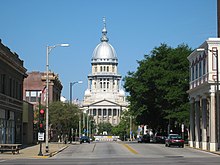Illinois House of Representatives
The Illinois House of Representatives ( Illinois House of Representatives ) is the lower house of the Illinois General Assembly , the legislature of the US state of Illinois . The Chamber was created in 1818 following the adoption of the first Illinois Constitution.
The Chamber of Parliament consists of 118 members, each representing an electoral district. The MPs are each elected for two-year terms; there is no limit to the terms of office. In contrast, terms of office in the Illinois Senate range from two to four years.
The House of Representatives boardroom, along with the State Senate, is located in the Illinois State Capitol in the capital, Springfield . The first official working day of each year is the second Wednesday in January.
Duties of the House of Representatives
The Chamber's primary duties are to pass bills, approve the state budget, influence federal constitutional amendments, and propose those for Illinois. It also has the power to overturn appeals from the governor by a three-fifths majority. The Chamber also has the power to prosecute officials of the executive and judiciary branches for misconduct.
Structure of the chamber
The Chairman of the House of Representatives is the Speaker of the House . He is elected every two years by the members of the Chamber. The speaker is responsible for the legislative process and oversees the assignments to the various committees. The speaker has been the Democrat Michael Madigan since 1997 .
Other important office holders are the majority leader and the opposition leader ( minority leader ), who are elected by the respective parliamentary groups. Majority leader of the Democrats is Barbara Flynn Currie , minority leader of the Republicans is Tom Cross .
Change in the Chamber
Prior to the 1980 Cutback Amendment to the state constitution, Illinois was divided into 59 legislative districts. Each of these had three MPs in the House of Representatives. The chamber thus had 177 members. Illinois also had an extraordinary and distinctive electoral system that suggested cumulative voting : Each individual voter cast three legislative votes and could choose either one vote for each of the three candidates, one candidate for all three votes (better known as a bullet vote ), or even give two candidates one and a half votes. After the Cutback Amendment was passed, this system was abolished and MPs were elected from 118 individual constituencies.
Composition after the 2010 election
| Political party | MPs | |
|---|---|---|
| Democratic Party | ||
| Republican Party | ||
| total | 118 | |
| Majority off | 60 | |
Web links
-
Illinois General Assembly - House (English)
- Illinois House Republicans (English)
- Illinois House Democratic Caucus (English)
- Project Vote Smart - Illinois House of Representatives (English)

